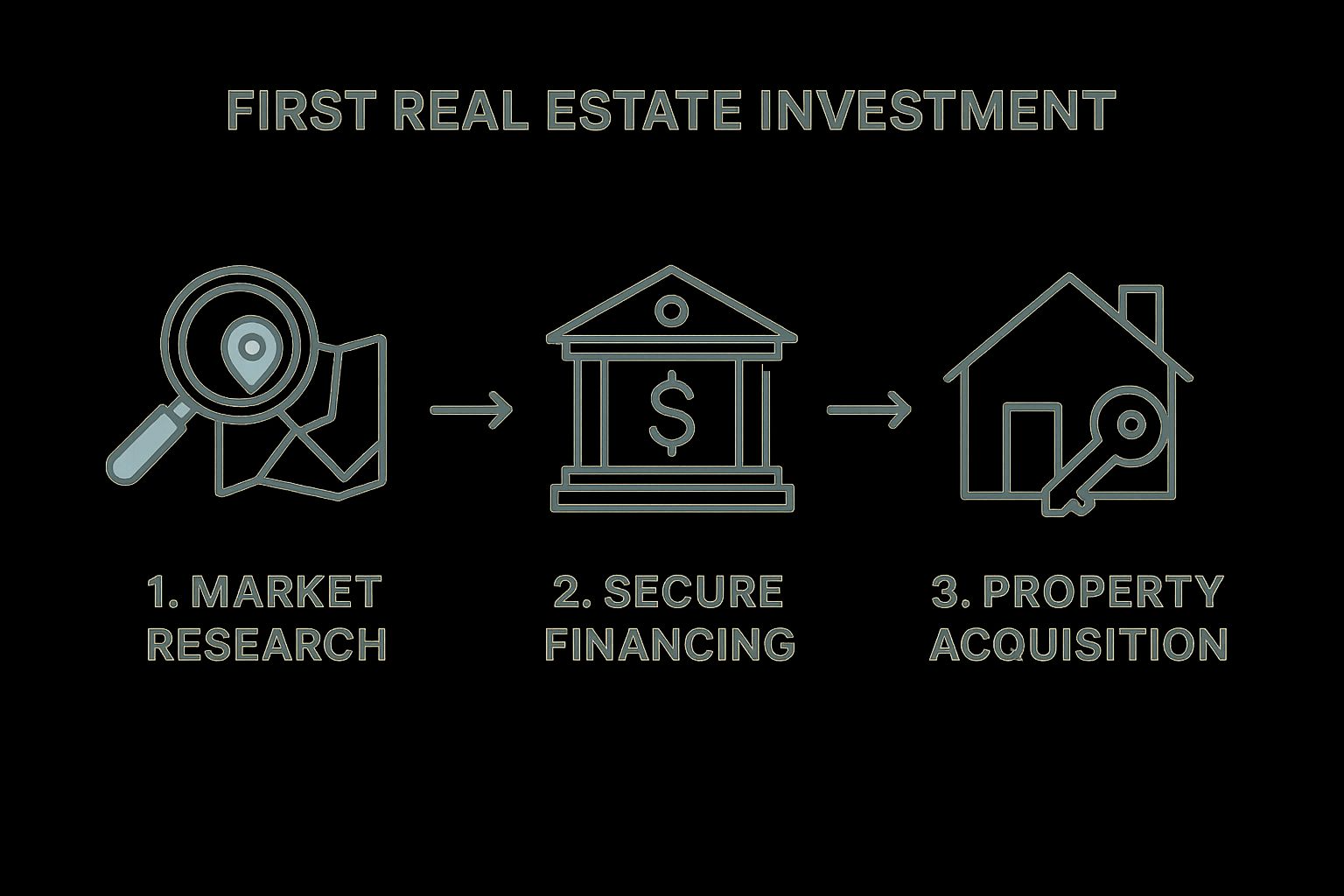Your 2025 Guide to Real Estate Investment for Beginners
So, you're thinking about investing in real estate. It's a smart move. At its core, it’s pretty simple: you buy a property to generate income through rent, or you sell it down the road for a profit. You’re using a physical asset to build wealth for the long haul.
But we get it—starting out can feel like a huge step, especially in the Okanagan market. The key is to start with a solid game plan and a clear understanding of the basics.
Starting Your Okanagan Real estate Investment Journey
If you're curious about building real wealth through property, you've landed in the right spot. Diving into real estate, especially in a sought-after market like Kelowna, can feel intimidating. But trust us, it’s more achievable than you might think.
This guide is your first step. We'll give you a clear roadmap so you have the confidence to make your first move.
Understanding the Core Concepts
Before we get into the weeds, let's get you comfortable with a few key terms that you'll hear constantly. Think of these as the building blocks for any smart real estate investment.
Here's a quick rundown of the essential terms every new investor in the Okanagan should understand.
Term What It Means for Your Investment Okanagan Example
Appreciation | The increase in your property's value over time. | The Kelowna market has seen significant appreciation due to high demand and population growth, boosting long-term returns for property owners. |
Cash Flow | The money left from rent after paying all expenses (mortgage, taxes, insurance, maintenance). | A condo near UBCO rents for $2,500/month. After $2,100 in total expenses, your positive cash flow is $400 per month. |
Equity | The portion of the property you actually own—the difference between its market value and your mortgage balance. | Your $600,000 property has a $450,000 mortgage. Your equity is $150,000, and it grows with each mortgage payment and as the property appreciates. |
These concepts are the foundation of your investment strategy, helping you measure profitability and growth.
At its heart, real estate investing is about making your money work for you. You build equity in an asset you can see and touch, all while your tenant helps pay down the mortgage.
Why It Works in Kelowna
These principles apply everywhere, but they’re particularly powerful in a market like ours. The demand for Kelowna homes for sale and rental properties in cities like Vernon and Penticton is consistently strong.
What’s fuelling this? People are flocking to the Okanagan for the lifestyle, students are attending UBCO, and our tech sector continues to grow. For a new investor, this creates a fantastic opportunity.
A robust rental market makes it easier to find great tenants and maintain a steady cash flow. This powerful combination of consistent rental demand and long-term appreciation potential makes the Okanagan an ideal place to start your investment journey.
Alright, you’ve got the theory down. Now, let’s get to the fun part: picking a location. And let us tell you, the Okanagan Valley isn't just a pretty face; it’s a powerhouse for real estate investment. Understanding why is your first real strategic advantage.
The valley’s appeal is much deeper than its stunning lakes and world-class vineyards. Serious economic engines are humming under the surface, creating a resilient and growing housing market. For a beginner, that’s exactly what you want to see.
A Thriving and Diverse Local Economy
A solid economy means jobs. And jobs mean a steady stream of people who need a place to call home. The Okanagan's secret weapon is its economic diversity. We've got a healthy mix of sectors that keep housing demand strong and consistent.
You can see it in action everywhere you look:
Tech Hub: Kelowna's tech scene is booming, pulling in skilled professionals from all over the country. Every one of them needs quality housing.
Healthcare Expansion: With massive projects like the ongoing expansion at Kelowna General Hospital, the demand for rentals from healthcare workers is a constant.
Tourism Powerhouse: All the way from Penticton to Vernon, the tourism and hospitality industries employ thousands, fuelling a huge need for both long-term and seasonal rentals.
This economic mix builds a stable foundation for the real estate market. It protects us from the wild swings you see in single-industry towns. For you, the investor, that translates to more predictability and less risk.
Unstoppable Population Growth
Bottom line: people want to live here. The Okanagan lifestyle is a massive draw, and the population numbers prove it. Kelowna consistently lands on the list of Canada's fastest-growing census metropolitan areas.
This flood of new residents is the single biggest driver of our rental market. It’s simple supply and demand. More people moving in means more tenants hunting for homes. This keeps vacancy rates low and puts upward pressure on rental prices—which is music to the ears of any investor looking for reliable monthly cash flow.
The real magic for an investor happens when a strong economy meets rapid population growth. It creates the perfect conditions for both steady rental income and long-term property appreciation.
Tangible Investment Opportunities
Okay, let's make this real. The demand isn't just a vague concept; it creates specific, actionable opportunities for a savvy beginner.
For example, think about the constant demand for student housing around the University of British Columbia Okanagan (UBCO). If you own a condo or a townhome anywhere near that campus, you’re almost guaranteed to have a lineup of potential student tenants every single year.
Or look over at the growing communities in West Kelowna. Young families are flocking there for the extra space and family-friendly amenities, creating a massive appetite for single-family rental homes with a bit of a yard. By zoning in on these micro-markets, you can find a niche that fits your investment goals perfectly.
This blend of a rock-solid economy, a booming population, and specific, localized demand makes the Okanagan an incredible place to start building your real estate portfolio. For a deeper look at specific towns and neighbourhoods, check out our guide on the best place to invest in real estate in BC.
Finding the Right Investment Property for You

Alright, you've seen why the Okanagan is a fantastic place to invest. Now for the fun part—finding the property that’s the right fit for you. Your first investment needs to line up with your financial goals and the amount of time and energy you're willing to commit.
There’s no one-size-fits-all answer here. The best choice is deeply personal and depends on your strategy, risk comfort level, and lifestyle. Let's break down the most common starting points for new investors here in the Okanagan.
Single-Family Homes: The Classic Choice
When most people picture a rental property, a single-family home is what comes to mind. It's a classic for a reason. These properties tend to attract stable, long-term tenants—think families who want to settle into a neighbourhood and stick around for a few years.
That stability means less tenant turnover, saving you the headache and expense of constantly finding new tenants. A family renting your house in a quiet Vernon neighbourhood is more likely to treat it like their own, which is a massive win.
Of course, you’re on the hook for everything. The roof, the furnace, the landscaping—it all falls on you. This can mean more hands-on work and the potential for larger, unexpected repair bills.
Condos and Townhouses: Lower-Maintenance Living
If the thought of weekend yard work or late-night plumbing emergencies gives you pause, a condo or townhouse might be a much better entry point. The biggest draw is the low-maintenance lifestyle. The strata corporation handles all the big-ticket exterior items like roofing, landscaping, and amenities.
This makes them an ideal "lock-and-leave" style of investment. A downtown Kelowna condo near the hospital, for instance, is a magnet for young professionals or healthcare workers who prioritize convenience over a private yard.
The trade-off? You'll have monthly strata fees eating into your profit margin, so you have to bake those into your cash flow analysis. You also give up some control and must follow the strata's bylaws, which can sometimes include rental restrictions.
Properties With Basement Suites: The Kelowna Favourite
Here in the Okanagan, buying a home with a legal basement suite is an incredibly popular—and powerful—investment strategy. It’s a brilliant way to squeeze maximum income out of a single property. You get two rental incomes helping to pay down one mortgage.
This "house hacking" approach can seriously boost your cash flow. You could live in the main part of a house in a West Kelowna suburb and let your basement tenant pay a huge chunk of your mortgage. Or, you could rent out both units for even stronger returns.
The dual-income potential of a suited property provides a built-in safety net. If one unit is vacant for a month, you still have income from the other to help cover expenses.
While the purchase price for a suited home might be higher, the financial upside often makes it one of the smartest moves for a new investor in the Kelowna real estate market. The local rental scene has its own quirks, so it's worth checking out our guide on how to find rentals in Kelowna for more specific insights.
What To Look For in Any Property
No matter what type of property you choose, a few universal truths apply. Location is king. You want a property that’s close to key amenities like good schools, shopping centres, parks, and transit routes. A convenient location is always an easier sell to a wider pool of potential tenants.
Next, get real about the property’s condition. A fixer-upper might look like a bargain, but renovation costs can quickly spiral out of control. For your first go, finding a property that’s in solid shape can save you a world of pain. Always get a thorough home inspection to uncover any hidden problems before you sign on the dotted line.
How to Finance Your First Investment Property

Let's talk money. Figuring out how you'll actually pay for your first property is often the biggest hurdle for new investors. It can feel like a tangled web of rates, terms, and paperwork, but it's really about finding the right tool for the job.
We'll walk you through the most common ways to fund your purchase so you can walk into your mortgage broker's office with confidence. The financial path you choose will shape your entire investment journey, so getting this part right is absolutely key.
Traditional Investment Mortgages
This is the tried-and-true route for a reason. An investment property mortgage is a lot like the one on your own home, but there are a few key differences you need to be aware of.
For starters, lenders in Canada almost always require a bigger down payment for investment properties—you’re looking at a minimum of 20% of the purchase price. They see a non-owner-occupied property as a slightly higher risk. You’ll probably notice that the interest rates are a touch higher, too.
Getting pre-approved is your first critical move. Lenders in BC will be looking closely at:
Your Credit Score: A strong score shows you’re a reliable borrower.
Your Income and Employment History: They want to see stable, predictable cash flow.
Your Debt-to-Income Ratio: This measures how much of your monthly income is already spoken for by other debt payments.
Your Down Payment Source: Lenders need proof that your down payment isn't another loan.
For a deeper dive into funding your purchase, check out our in-depth guide covering various down payment options for your home.
Using the Equity in Your Current Home
If you already own a home in the Okanagan, you might be sitting on a powerful investment tool without even realizing it. The equity you’ve built up—the difference between your home’s current value and what you still owe on your mortgage—can be unlocked to fund your first rental.
The most popular way to do this is with a Home Equity Line of Credit (HELOC). Think of it as a revolving line of credit that uses your home as collateral. You can draw from it as needed to cover the down payment and closing costs on your new investment. You only pay interest on the amount you actually use.
This is a favourite strategy among seasoned Kelowna investors. It lets you leverage an asset you already own to acquire a new one that starts generating income. It’s a smart way to make your assets work harder for you.
Partnering Up for Your First Purchase
Feeling stretched by that down payment? You don't have to go it alone. Teaming up with another investor—whether it's a trusted friend, family member, or colleague—is a fantastic way to get your foot in the door sooner.
By pooling your resources, you can more easily hit that 20% down payment target and share the financial risks. Of course, you’ll need a rock-solid partnership agreement drawn up by a lawyer. It should clearly spell out everyone's responsibilities, ownership percentages, and—most importantly—an exit strategy. It can be a powerful way to make your first move.
Having your financing lined up ahead of time is crucial. You need to be ready to act when the right opportunity appears.
Ultimately, securing financing comes down to solid preparation and an honest conversation with your mortgage professional. With the right strategy, you'll be well on your way to owning your first piece of the Okanagan real estate market.
How to Analyze a Deal Like a Pro
So, how do you know if a potential investment is a winner or just looks good on paper? It all boils down to the numbers. A beautiful property can be a financial nightmare if the math doesn't add up. Learning to analyze a deal is the most critical skill you can build.
Forget the complicated university lectures. We'll walk you through the simple math every investor needs to know to separate a smart investment from a costly mistake.
The Heart of the Deal: Cash Flow
Your number one focus should always be cash flow. This is the money left in your pocket each month after you’ve collected rent and paid all the property's bills. Positive cash flow means the property is paying for itself and then some.
Negative cash flow? That means you're feeding it with your own money every single month. We call that a hobby, not an investment.
Here's how you figure it out:
Gross Rental Income: The total rent you collect.
Vacancy Allowance: No property stays rented 100% of the time. It's smart to budget for reality by setting aside 5-8% of your rental income to cover empty months.
Total Expenses: This is everything else—your mortgage payment, property taxes, insurance, strata fees (if applicable), maintenance funds, and property management fees.
The formula is straightforward: Gross Rental Income - Vacancy Allowance - Total Expenses = Monthly Cash Flow.
A deal that looks amazing on the surface can completely fall apart once you factor in all the real-world expenses. Never, ever skip a deep dive into the numbers.
A Kelowna Condo Case Study
Let's make this real. Imagine a one-bedroom condo in Kelowna's popular Lower Mission neighbourhood.
Purchase Price: $500,000
Down Payment (20%): $100,000
Mortgage Amount: $400,000
Now, let's crunch the monthly numbers.
Income & Expenses Monthly Amount Notes
Gross Rental Income | $2,400 | Based on current market rates in the area. |
Vacancy Allowance (5%) | -$120 | A conservative buffer for when the unit is empty. |
Mortgage Payment | -$1,900 | Estimated on a $400k loan at 5.5% over 25 years. |
Property Taxes | -$200 | Based on Kelowna's municipal tax rates. |
Home Insurance | -$50 | Standard landlord insurance policy. |
Strata Fees | -$300 | Covers building maintenance, amenities, etc. |
Maintenance Fund (5%) | -$120 | Set aside for future repairs (new appliances, paint). |
Net Cash Flow | -$290 | This property has negative cash flow. |
See that? Even with strong rent, this property would cost you $290 out of your own pocket each month. This is the kind of discovery you need to make before you buy. To make this deal work, you'd have to find a way to lower the purchase price, lock in a better interest rate, or find a similar property with much lower strata fees.
This simple process shows the essential steps to your first investment, from initial research to finally getting the keys.

This visual roadmap simplifies the journey, breaking it down into three core stages. A successful investment is a clear, sequential process.
Other Key Metrics to Know
While cash flow is king, a few other numbers help you compare different properties and size up their long-term potential.
Capitalization Rate (Cap Rate): This metric tells you the rate of return on a property if you bought it with all cash. You calculate it by dividing the Net Operating Income (NOI)—your income after expenses but before the mortgage—by the purchase price. A higher cap rate generally points to a better return.
Return on Investment (ROI): This is the big one. It measures how hard your actual cash in the deal (your down payment) is working for you. It's your annual cash flow divided by your total cash invested. This is a powerful way to see the true performance of your money.
Analyzing deals properly gives you the power to make decisions based on data, not emotion. It’s the difference between hoping for a good outcome and building a strategy for one.
Common Questions from New Okanagan Investors
Jumping into real estate is a huge decision, and it’s totally normal to have a million questions swirling around. We get it. You want to feel confident you're on solid ground before you take the leap.
Here are some straight-up answers to the questions we hear most often from first-time investors eyeing the Okanagan market.
How Much Money Do I Really Need to Start?
This is almost always the first thing people ask. While the exact number changes from property to property, there's a pretty clear baseline you need to hit for any investment property in Canada.
You’re looking at a minimum down payment of 20% of the purchase price. So, if you’re eyeing a $500,000 condo in Kelowna, you'll need $100,000 liquid for the down payment.
But that's not all. You also have to cover closing costs—think legal fees, property transfer tax, and the like—which usually add another 1.5% to 4% of the home's price to your upfront costs.
We also strongly advise having a healthy cash reserve. A good rule of thumb is to have three to six months' worth of total expenses (your mortgage payment, taxes, strata fees) tucked away. This little nest egg is your safety net for a surprise vacancy or a sudden repair, ensuring you’re never caught scrambling.
Should I Manage the Property Myself?
This is a big one, and the right answer really boils down to a trade-off: your time versus your money.
Going the self-management route is a fantastic way to maximize your monthly cash flow, and it keeps you in the driver's seat. If you live nearby, enjoy being hands-on, and have the flexibility to field tenant calls or fix a minor issue, it can be a really empowering experience. You'll learn the landlord business inside and out.
On the flip side, if your time is your most valuable asset, or you'd just rather not deal with finding tenants and fixing leaky faucets at 10 p.m., hiring a professional property manager is a game-changer. They take care of all the day-to-day headaches for a percentage of the monthly rent. For a lot of investors, that fee is a small price to pay for total peace of mind.
"The right property manager doesn't just collect rent; they protect your asset. Their expertise in tenant screening, local rental laws, and maintenance can save you thousands in the long run." - AJ Hazzi, Founder of Vantage West Realty
What Are the Biggest Risks for a New Investor?
Look, every investment has risks. The goal is to understand the potential pitfalls so you can build a smart plan to sidestep them.
For beginners diving into the Okanagan real estate market, here are the main things to watch out for:
Negative Cash Flow: This is when your monthly expenses are higher than what you collect in rent. It's the #1 mistake we see new investors make, and it's almost always preventable by running your numbers meticulously before you ever sign on the dotted line.
Extended Vacancies: An empty unit doesn't pay for itself. You can seriously reduce this risk by buying in a high-demand area with a steady stream of renters, like near UBCO or Kelowna General Hospital.
Unexpected Repairs: A furnace that dies in January or a major plumbing leak can vaporize your profits for the year. Your best defence? A thorough home inspection upfront and a dedicated maintenance fund you contribute to regularly.
Working with a team that has been around the block is the best way to navigate these challenges. We help you spot potential red flags from a mile away and craft a solid strategy, so you can make your first move with your eyes wide open.
Embarking on your real estate investment journey in the Okanagan is an exciting prospect. With the right guidance and a solid plan, you can build lasting wealth. If you’re ready to explore your options, the team at Vantage West Realty is here to help you make your next move with confidence. Reach out today to get started.




